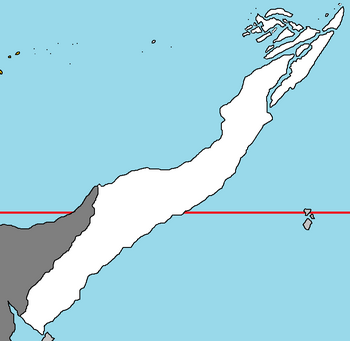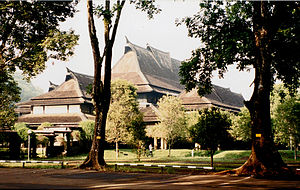Caruban: Difference between revisions
(→Government and politics: Described electoral districts as "single-member") |
(Added land area, pop density, and year when GDP PPP estimate took place) |
||
| Line 77: | Line 77: | ||
|area_rank = | |area_rank = | ||
|area = <!--Major area size (in [[Template:convert]] either km2 or sqmi first)--> | |area = <!--Major area size (in [[Template:convert]] either km2 or sqmi first)--> | ||
|area_km2 = | |area_km2 = 153696 | ||
|area_sq_mi = <!--Area in square mi (requires area_km2)--> | |area_sq_mi = <!--Area in square mi (requires area_km2)--> | ||
|area_footnote = <!--Optional footnote for area--> | |area_footnote = <!--Optional footnote for area--> | ||
|percent_water = | |percent_water = | ||
|area_label = | |area_label = Total | ||
|area_label2 = <!--Label below area_label (optional)--> | |area_label2 = <!--Label below area_label (optional)--> | ||
|area_data2 = <!--Text after area_label2 (optional)--> | |area_data2 = <!--Text after area_label2 (optional)--> | ||
| Line 88: | Line 88: | ||
|population_estimate_year = | |population_estimate_year = | ||
|population_census = 26,370,120 | |population_census = 26,370,120 | ||
|population_census_year = | |population_census_year = 2010 | ||
|population_density_km2 = | |population_density_km2 = 171.5 | ||
|population_density_sq_mi = | |population_density_sq_mi = | ||
|population_density_rank = | |population_density_rank = | ||
| Line 95: | Line 95: | ||
|GDP_PPP = $535.7 billion | |GDP_PPP = $535.7 billion | ||
|GDP_PPP_rank = | |GDP_PPP_rank = | ||
|GDP_PPP_year = | |GDP_PPP_year = 2020 | ||
|GDP_PPP_per_capita = $20,314 | |GDP_PPP_per_capita = $20,314 | ||
|GDP_PPP_per_capita_rank = | |GDP_PPP_per_capita_rank = | ||
|GDP_nominal = $435.7 billion | |GDP_nominal = $435.7 billion | ||
|GDP_nominal_rank = | |GDP_nominal_rank = | ||
|GDP_nominal_year = | |GDP_nominal_year = 2020 | ||
|GDP_nominal_per_capita = $16,522 | |GDP_nominal_per_capita = $16,522 | ||
|GDP_nominal_per_capita_rank = | |GDP_nominal_per_capita_rank = | ||
| Line 107: | Line 107: | ||
|Gini_rank = | |Gini_rank = | ||
|Gini_year = | |Gini_year = | ||
|HDI_year = | |HDI_year = 2019 | ||
|HDI = 0.881 | |HDI = 0.881 | ||
|HDI_change = decrease | |HDI_change = decrease | ||
Revision as of 11:01, 25 July 2021
Caruban චිරෙබොන් Cirebon | |
|---|---|
| Motto: Aking karapatan, ating batas (My right, our law) | |
| Anthem: Diwa ng Bayan (Song of the Nation) | |
 | |
| Capital and largest city | Bonton |
| Official languages | Tagaplo, Pratoaboan, Caticeze-English |
| Demonym(s) | Carubanese |
| Government | Unitary semi-presidential republic |
• Lakan | Merob Wibowo |
• Prime Minister | William Langins |
| Legislature | Parliament L Batasan |
| Formation | |
• Republic of Strackenz | January 23, 1579 |
• Rumaztrian rule | September 1, 1708 |
• Self-Government Act | October 26, 1807 |
• Carubanese Parliament Act | February 22, 1826 |
• Independence Act | March 15, 1960 |
| Area | |
• Total | 153,696 km2 (59,342 sq mi) |
| Population | |
• 2010 census | 26,370,120 |
• Density | 171.5/km2 (444.2/sq mi) |
| GDP (PPP) | 2020 estimate |
• Total | $535.7 billion |
• Per capita | $20,314 |
| GDP (nominal) | 2020 estimate |
• Total | $435.7 billion |
• Per capita | $16,522 |
| HDI (2019) | very high |
| Currency | Carubanese dollar ($) |
| Date format | mm-dd-yyyy |
| Internet TLD | .cr |
Caruban (Tagaplo: චිරෙබොන්, Cirebon), officially the Republic of Caruban, is a country in Ausiana. Vulkaria borders the country from the west, the Tervali Islands from the south, and the Samson Ocean from the east. A former Rumaztrian colony, much of its modern heritage is intertwined with central Ausianan culture. Its native residents, the Tagaplo people, share a long historical relationship with Vulkaria. Due to Rumaztria rule, the nation is bilingual and speaks Tagaplo and Caticeze-English. Pratoaboan, a Vulkarian language, is only recognized by various local governments, most of which are Tagaplo communities. The peninsular country is surrounded by the Samson Ocean. The capital and largest city in Caruban is Bonton.
The Tagaplo people arrived in the Caruban Peninsula in 900 BC. They settled in the Lusong archipelago, the group of islands north of the peninsula. Early Vulkarian states introduced the Tagaplo to a sedentary, agrarian lifestyle. In the 6th Century, the Tagaplo migrated to the mainland peninsula. The remaining tribes in the Lusong Islands maintained their sea-nomad traditions. In the mainland, the Tagaplo founded thalassocracies in large, stone-walled settlements. During the Warring City-States period (1500-1850), Vulkarian warlords conquered Caruban and formed the Republic of Strackenz. Pratoaboan-speaking Vulkarians colonized the peninsula and assimilated the mainlander Tagaplo. In 1708, the Rumaztrian Empire invaded Caruban to secure trade routes in the Samson Ocean. After the Zamastan War of Independence, Rumaztria enacted colonial reform to maintain its other colonial possessions. In Caruban, self-government was enacted in 1807 to prepare the territory's transition to an autonomous parliamentary democracy, finalized in the Carubanese Parliament Act of 1826. Clashes between colonial and Tagpalo politicians culminated into "Vorherrschaft" (Pratoaboan word for "supremacy "), a racist system of minority representation that denied the will of the majority, indigenous population. Vorherrschaft ended in 1960 when the Rumaztrian parliament granted Caruban independence.
Caruban is a developed country with a high-income economy. The service industry is the top economic sector, followed by manufacturing as second and agriculture as third. Carubanese citizens enjoy a high quality of life, spanning from benefits in government transparency, free education up to high school, universal healthcare, and protections in civil liberties and economic freedom. The country is a republic with an elected, unicameral parliament. The prime minister, currently William Langins, is the head of government. A popularly elected Lakan, currently Merob Wibowo, is head of state. In its bid to institute permanent neutrality, Caruban renounced its right to declare war and abolished standing armed forces in the 1964 Constitution.
Etymology
The name Caruban traces its origin from an old legend. It usually varies, but the story always involves a Tagaplo merchant was visiting Vulkaria. When Vulkarians asked the merchant about their home country, they assumed the Vulkarians referred to their variety of wares, calling them "caruban."
"Caruban" (චරුබන්) is an old Tagaplo word for "mixed." Over the years, foreigners used other names like "Cheribon," "Chirebon," and "Sirivon." Vulkarians used "Strackenz" for the peninsula, and it did become a name for a Vulkarian rump state in the 16th-19th centuries. In 1960, Cirebon (චිරෙබොන්) was adopted as the official native translation.
At the beginning of Rumaztrian rule, when Caruban was still a loose confederation of indigenous tribes, Vulkarian cities, and Rumaztrian colonies, the colonial administration used the title "United Federation." The Self-Government Act in 1807 used the new title "Federation." In the 1964 Constitution, Caruban replaced the federal form of government with a unitary state, and the title "Federation" was replaced by "Republic."
History
Prehistoric to early history (Pre-1000 AD)
There has been human habitation in the Caruban Peninsula as long as 40,000 years ago. Sea nomads from Western Ausiana migrated to the peninsula in 900 BC. They settled in the Lusong Islands. Traders and settlers from Vulkaria arrived around the 1st Century AD, followed by Yuan in the 3rd Century AD. They established towns and ports along the southern coasts and introduced wet-rice farming (Yuan), pottery, and metallurgy (the latter two from Vulkaria). Their presence resulted in Vulkarian and Yuan influences in the local cultures. Increased trade in the mainland peninsula attracted migrants from the Lusong Islands.
A series of conquests erupted between the 7th and 9th Centuries, creating powerful, royal Tagaplo thassalocracies that dominated the peninsula. By the 10th Century, the Tagaplo kingdoms in the north and Vulkarian and Yuan city-states in the south divided the peninsula.
Government and politics
Caruban is a parliamentary democracy with a semi-presidential executive modeled on the Quetanan system. Executive authority, or leadership of the government, is vested in a cabinet led by the head of state known as the Lakan. In the old days, the Lakan was an absolute ruler or paramount chieftain of the Tagaplo people. The modern Lakan enforces law, grants pardons, receive ambassadors, appoints cabinet officials and supreme court justices, and has reserve powers such as dissolving parliament and refusing to sign a bill into law. Under normal circumstances, the Lakan only exercises their powers on the advice of the Prime Minister and cabinet. For supreme court appointments, the Lakan takes advice from the Judicial Independence Commission.
The Carubanese Parliament is unicameral, legislates laws, and can remove the government through a vote of no confidence. Based on the rules of the Quetanan system, the 1964 Constitution enshrined the principles of parliamentary supremacy over the executive and judicial branches. Parliament democratically elects representatives every five years. Eligible formateurs in parliament, leaders of parties capable of winning an investiture vote, are nominated to become prime minister. After a general election or a vote of no confidence, the formateur of the winning party in an investiture vote will be appointed by the Lakan, as head of state, to form a government. Traditionally, the Lakan grants audiences to both the prime minister and the opposition leader to give minority parties a stronger voice in criticizing government policy. The cabinet, formed by the prime minister, is the highest policy-making body in the government and is collectively responsible for the consequences of their actions.
Elections are called by the Lakan either after every five years or after an investiture vote fails. The Lakan then dissolves parliament. Single-member districts called "pekan" (an old Tagaplo word for "market") are vacated upon dissolution and must nominate a candidate. A pekan candidate is usually elected by a local party from member residents. The candidate must win a simple plurality vote to represent local constituents as an MP or Member of Parliament.
The Batasan is the independent legislature for the Tagaplo people with devolved powers granted by the Carubanese Parliament. The Batasan's primary responsibility is to preserve Tagaplo cultural heritage. Unlike Carubanese Parliament, Batasan elects its members through party-list proportional representation. Winning parties are assigned seats based on the percentage of votes garnered by each party and the number of available seats (50). To qualify, parties must win at least 5% of the vote.
The Carubanese judicial system, headed by a chief justice, adjudicates on mixed common and civil law. The Supreme Court of Caruban is the highest court in the country. Court justices and officials are appointed non-politically under the strict rules implemented by the Judicial Independence Commission.
Culture
National anthem
Diwa ng Bayan is the national anthem of Caruban. Josias Pertiwi wrote the composition in 1878. The Carubanese Parliament commissioned Pertiwi to compose a hymn for the 1879 State Opening of Parliament. Pertiwi adopted the lyrics from Fr. Genesis Lambosa's 1836 poem "O Sintang Lupa."
The Tagaplo version is not a direct translation of the Caticeze-English version.
| Official Caticeze-English version (Diwa ng Bayan) |
Official Tagaplo version (Diwa ng Bayan) |
Literal translation of the Tagaplo text |
|---|---|---|
Land of the morning, |
O sintang lupa, |
O beloved land, |



